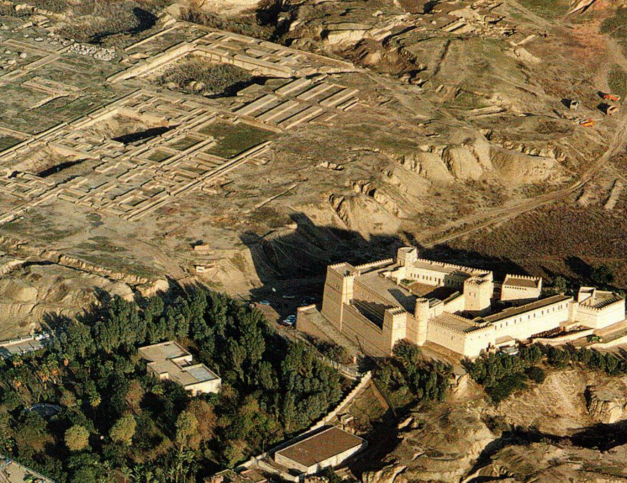The Term Purim and the Black Obelisk
As we know from the Book of Esther, the casting of lots – known as ‘Pur’ – was used by Haman to establish the date on which he intended to attack and murder the Jews of Shushan. Purim is a plural of that term. Scholars note that the date of Purim falls during a Persian festival. As such, apparently wishing to coincide the attack with Persian rejoicing, Haman had lots cast repeatedly (multiple Pur – or Purim) until the result called for a date during that time frame:
In the Book of Esther 3:7 we read:
“In the twelfth year of King Ahasueros, in the first month, i.e., the month Nissan, one cast the pur (i.e. the lot) in the presence of Haman, day by day and month by month (until it fell on the fourteenth day of) the twelfth month, i.e., the month of Adar.” Later in the same book (9:26) we read: “Therefore they called these days Purim, after the word (or: on account of the) pur.”
Remarkably, the term “Pur[im]” was confirmed by the discovery of the Black Obelisk in 1845. The Black Obelisk is a monument that details the military campaigns of the Assyrian king Shalmaneser III, including the conquest of the Kingdom of Israel in 841 BCE. It provided the first extra-biblical proof of the biblical stories, and also contains a reference to the use of lots (puru) for royal decision making. In 9th Century BCE Assyria, the order in which the individual ministers and governors succeeded each other was determined by lot. Shalmaneser III, in the thirtieth year of his reign, having run through the roster of his assistants, he started over again, as recorded on the Black Obelisk. The inscription reads:
“In my thirty-first year (i.e., 828 BCE), I cast the lot for the second time in front of the gods Ashur and Adad.”
One of Shalmaneser’s minister’s lots has survived and is now housed in the Yale Babylonian Collection. The “lot”, shown below, is a simple little cube inscribed on four sides, similar to modern dice, although with more detail inscribed on each side. The Assyrian word for lot is puru. It appears twice on the inscribed cube.
The translation reads:
“Oh Assur the great lord, oh Adad the great lord, the lot of Iahali the grand vizier of Shalmaneser king of Assyria, governor-of-the-land (for) the city of Kibshuni (in) the land of Qumeni, the land of Mehrani, Uqu and the Cedar Mountain, and minister of trad—in his year assigned to him by lot may the harvest of the land of Assyria prosper and thrive, in front of the gods Assur and Adad may his lot fall.”
In the native Akkadian text it reads:
“Ashshur belu rabu, Adad belu rabu, puru sha Iahili abarakku rabu sha Shulmanu-asharid shar mat Ashshur, shakin mati al Kibshuni, mat Qumeni, mat Mehrani, mat Uqu, mat erinni, rabi kari—ina limeshu purishu ebur mat Ashshur lishir lidmiq, ina pan Ashshur Adad purshu lidda.”
The technique of casting lots was equally well known in the Bible. The Bible records many different uses for the casting of lots, ranging from the division of the Promised Land among the twelve tribes by Joshua, to the finding of the culprit in the tale of Jonah, and to the gambling for the garment of the condemned man in Psalm 22—an image subsequently used by the Gospels in connection with the crucifixion.
Lot from Assyria – 9th Century BCE
The purpose of the lottery continued to change over time—from fixing the calendar of the Assyrians to fixing a date for the destruction of the Jews of the Persian Empire. But the terminology and the underlying technique remain the same: one casts the lots called pur or, in the plural, purim. And the festival of the fourteenth of Adar (originally the fifteenth, observed today as Shushan Purim) takes its name, we are told, from this very word for lots.
The Black Obelisk displays 190 lines of text distributed above and below five rows of reliefs that wrap around the four-sided stone. This text describes the major events in 31 military campaigns conducted by the Assyrian king Shalmaneser III. The reliefs in the second panel from the top on each face of the obelisk, according to the inscription below the picture, depict “The tribute of Jehu, son of Omri,” an event dated to about 841 B.C.
“Also anoint Jehu the son of Nimshi as king of Israel…” 1 Kings 19:16 (JPS Tanakh)
“ And Jehu struck down all that were left of the House of Ahab in Jezreel—and all his notables, intimates, and priests—till e left him no survivor.” 2 Kings 10:11 (JPS Tanakh)
The caption states the Israelite tribute is comprised of: “silver, gold, a golden bowl, a golden vase with pointed bottom, golden tumblers, golden buckets, tin, a staff for a king [and] purukhti fruits.”
Persian warriors from King Darius’ Palace in Susa, i.e. Shushan, Louvre Museum
Aerial picture of modern Shushan. In the foreground is a modern “palace,” built during the French archaeological expedition to Shushan (1897-1912), which is very close to the ruins of Xerxes’ palace.








